These six lack a common theme. I do find the botany of four of them to be annoying, but that is no theme. Leyland cypress has a new genus name, which I did not mention. I still do not believe that the native blue elderberry is the same species as the black elderberry of the East. I still do not know for certain if the double white angel’s trumpet is a hybrid, although I do believe that it is. Although I exceeded my preferred word count limit here, I tried to abbreviate some of the redundancy of nomenclature while including both Latin and common names with the same cultivar name. Otherwise, the first of these six would be Saccharum officinarum ‘Pele’s Smoke’, ‘Pele’s Smoke’ sugarcane, with ‘Pele’s Smoke’ mentioned twice, with a comma in between. I may continue this technique in the future.
1. Saccharum officinarum ‘Pele’s Smoke’ sugarcane continues to grow like a weed on the warm windowsill in the galley at work. It is not bronzing though. I suspect that this fresh new foliage will be too tender to survive outside even after early spring. It is no problem. It will simply make more. Many more cuttings are growing outside. They are slower but more resilient. For less redundancy, I used its same cultivar name after its species name and before its common name. Of course this explanation is longer than any redundancy.
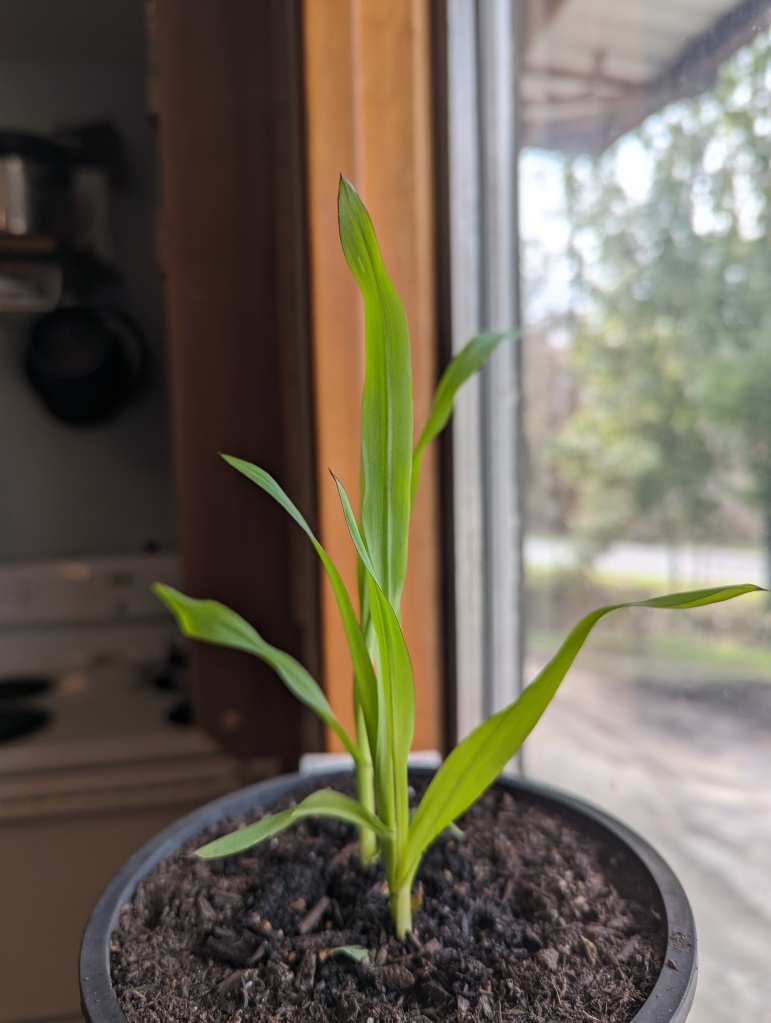
2. Sambucus cerulea, blue elderberry is classified by most botanists as a Western variety of American black elderberry. I know better. I am Californian. Regardless, I am growing a few cuttings from a few different parents because no one seems to know if they should be more productive with pollinators, like European black elderberry is. Four tagged bits are from the same very productive specimen, which must be removed from a landscape. The other pair is from a random roadside specimen. Three other pairs were added later.
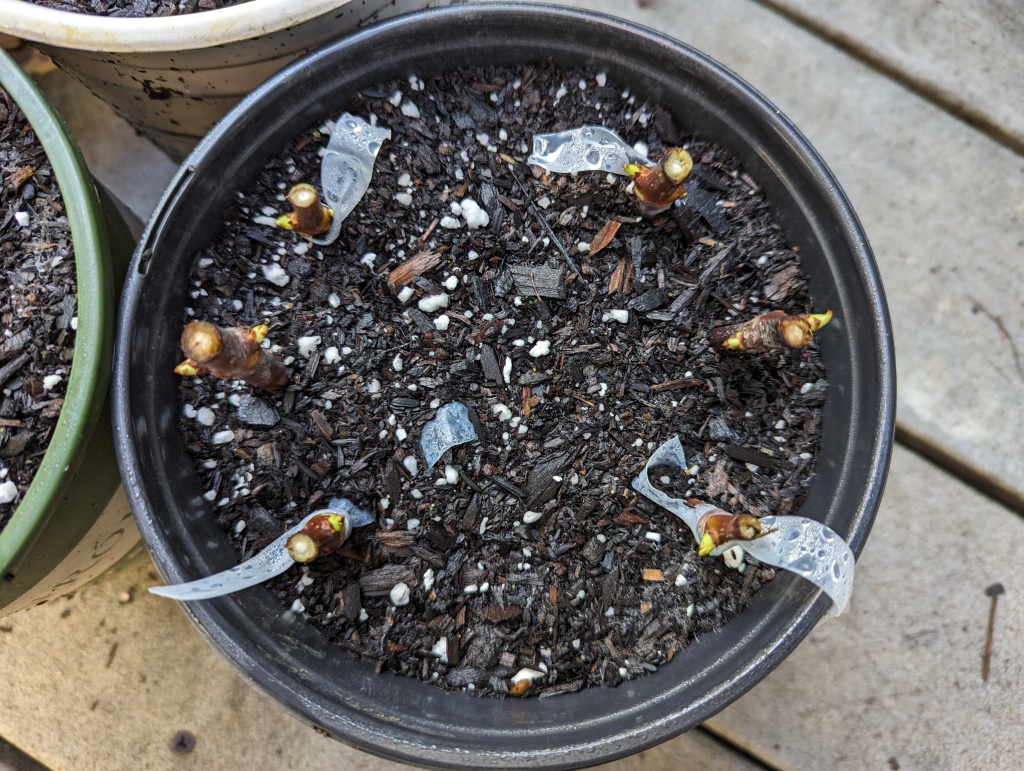
3. Agave americana, century plant is too prolific. We installed one of several ‘unwanted’ specimens and found all these pups within its can underneath. We can not use them all.
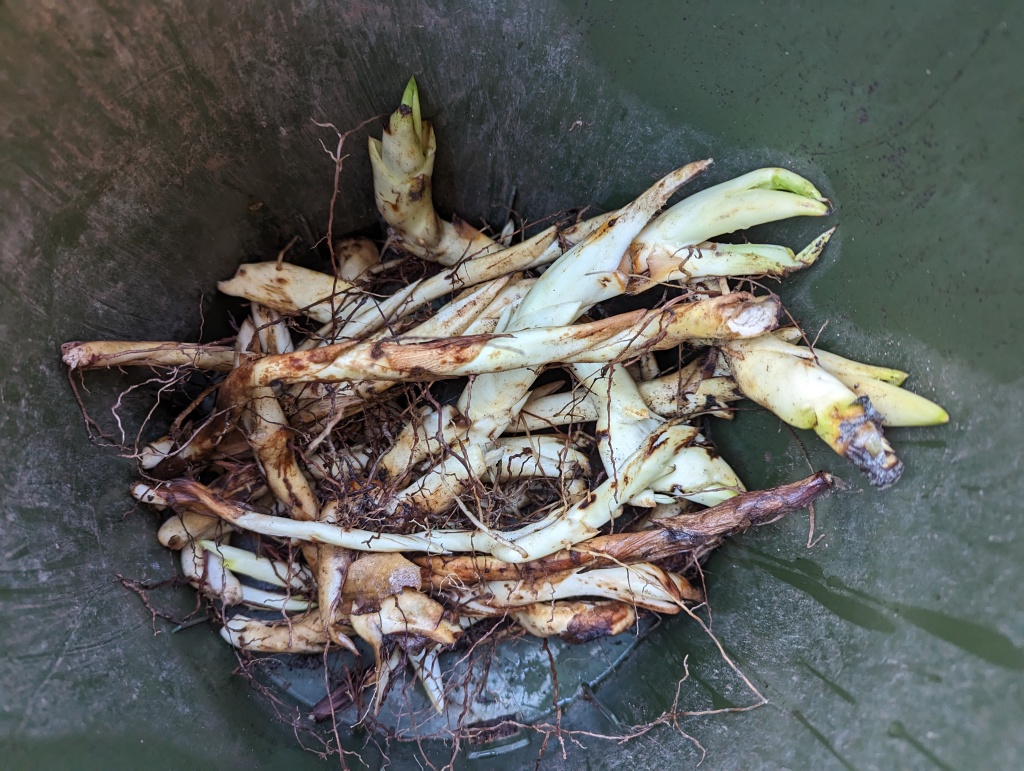
4. Ulmus parvifolia, Chinese elm became unavailable years ago after it was identified as a host for Dutch elm disease. Watersprouts continue to grow from a stump of a tree that was cut down years ago. If I could, I would grow several of this formerly familiar species.
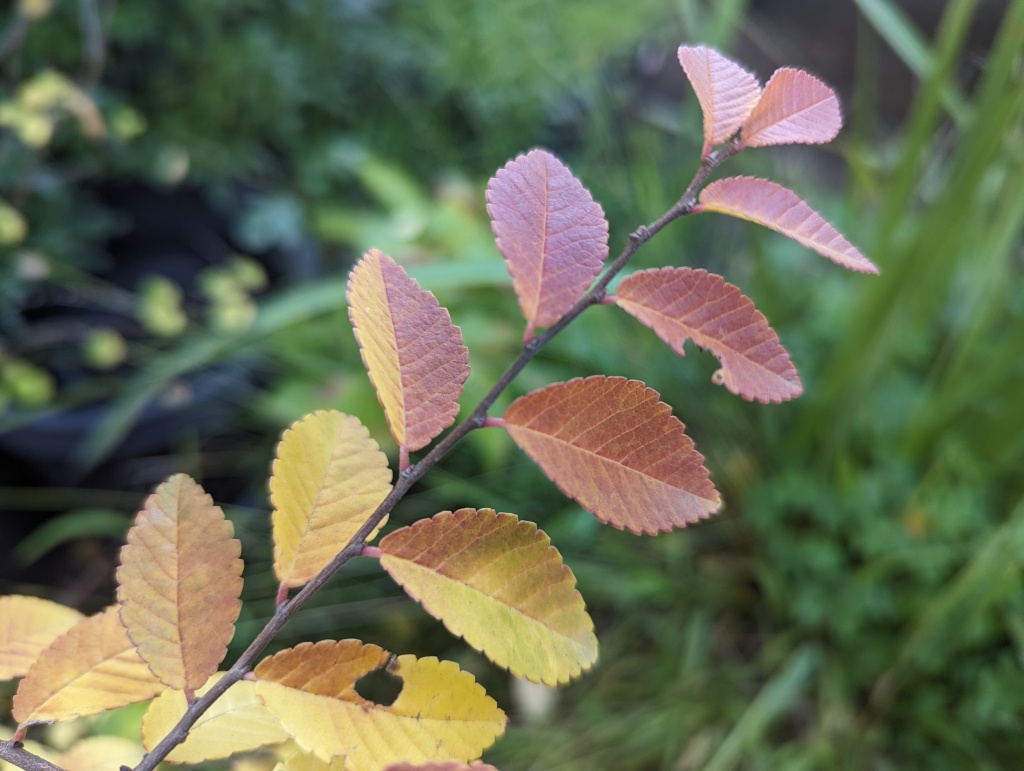
5. X Cupressocyparis leylandii, Leyland cypress is irrelevant to this illustration of how a chainsaw cuts if one side is sharper than the other. Another saw cut the flatter surface to the left. Incidentally, the ‘X’ preceding the genus name indicates an intergeneric hybrid.
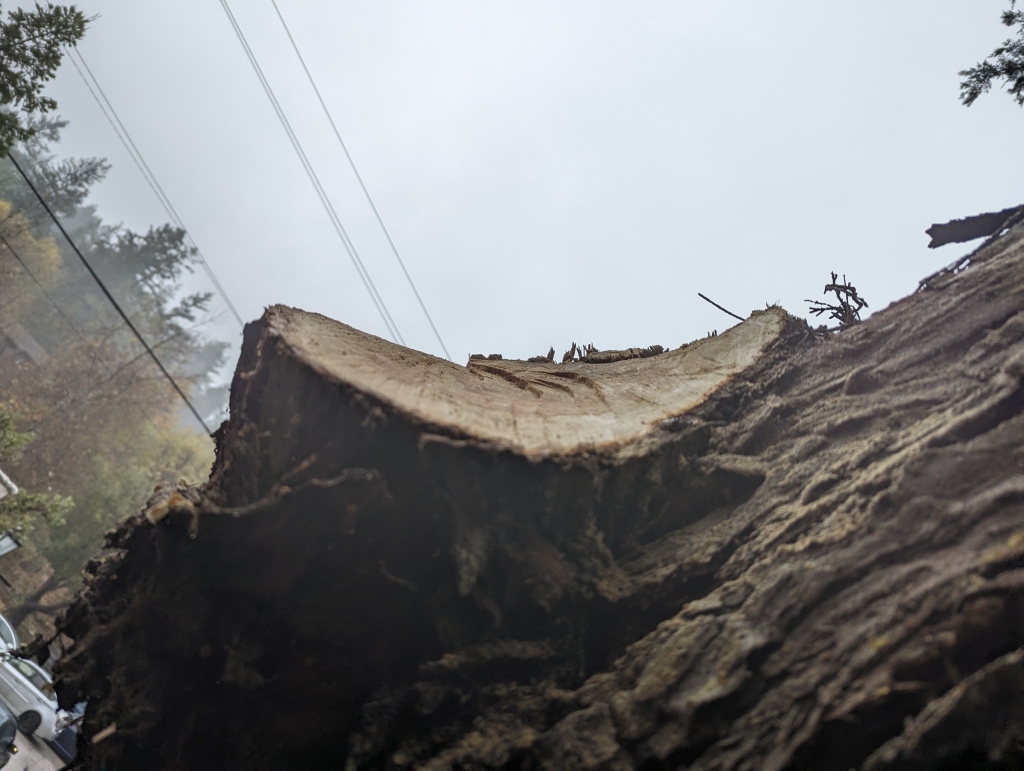
6. Brugmansia X candida ‘Double White’ angel’s trumpet should not bloom now. Either it does not know, or it does not care. Incidentally, the ‘X’ between the genus and species names indicates an interspecific hybrid. Like for the sugarcane, I used the same cultivar name after its species name, and before its common name. Is such abbreviation proper?
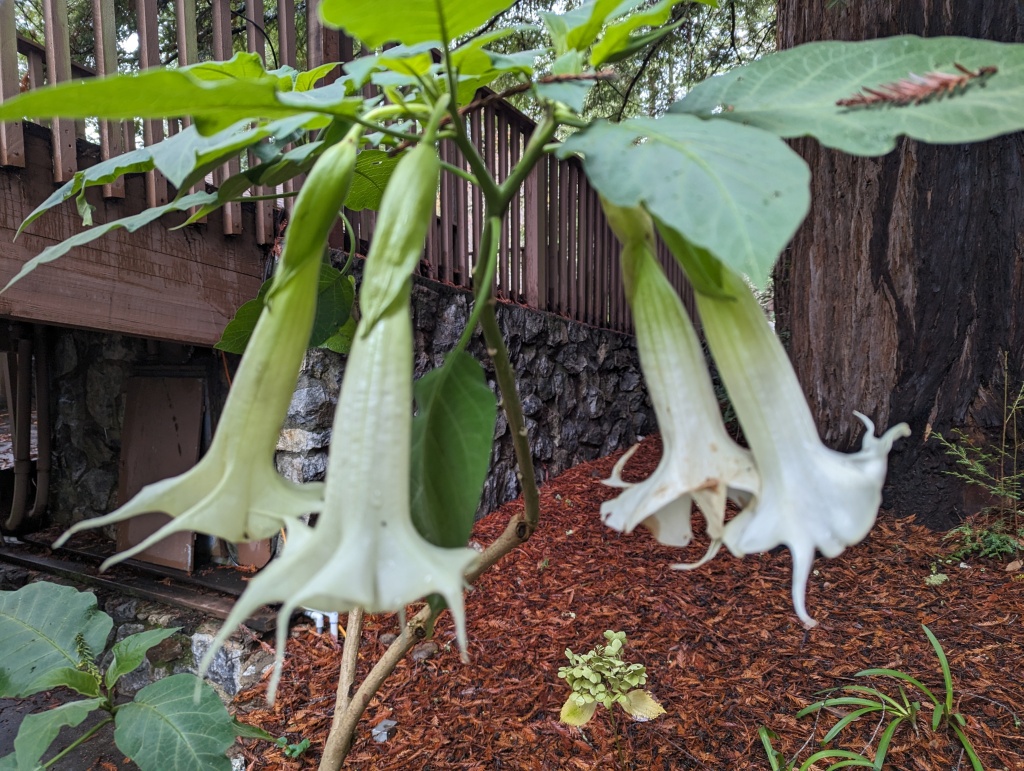
This is the link for Six on Saturday, for anyone else who would like to participate: https://thepropagatorblog.wordpress.com/2017/09/18/six-on-saturday-a-participant-guide/
I have a couple of plants on my windowsill beside me that I was given as cuttings, rooted them in water then potted them. I just enquired of the giver as to its identity and she says Saccharum officinarum ‘Rubra’. Mine do have a bit of purple tinge but otherwise look very much like yours. Hairy leaves and stems which I must try to photograph.
LikeLiked by 1 person
‘Rubra’ is likely an older variety rather than a modern cultivar. I have never encountered any of the sugarcanes in nurseries. The most common sort that I remember in the Los Angeles region resembled ‘San Diego Yellow’. Anyone who wanted to grow it could just get a piece from a neighbor or just find it growing wild and falling into a sidewalk from a neglected garden somewhere. Those that we knew as ‘Rubra’ were reddish with green stripes, rather than monochromatically bronzy brown like ‘Pele’s Smoke’. So, they were both greener and redder, and quite pretty, although some seemed to be variable. I mean, some were quite tall and scrawny, and some were shorter and fluffier. That is why I think that they were more likely a variety rather than a cultivar. ‘Pele’s Smoke’ is more uniformly . . . brown. It is the color of those old fashioned smoky topaz windows from the 1970s. Actually, I am not so keen on it. I only grow it because it became available. I really should get some of the common sort when I return to Los Angeles in spring.
LikeLike
Happy New Year, Tony,
I am curious about the Sambucus. Do people ever do DNA sequencing on plants to identify them based on DNA rather than appearance and other parameters one might otherwise use to ID a plant? Or is it too messy because one would first have to agree how much difference makes a plant one species rather than another.
Side note on plant (or rather fungus) ID. The US has seen a rash of poisonings lately, caused by people IDing mushrooms as edible based on an app. The right ID can make a difference, and appearances can be deceiving. Don’t eat any strange mushrooms!
LikeLike
Hello. Incidentally, your comment was filtered out as spam. I have no idea why. I have never responded to a comment by this means before, so I do not know if it will go through.
Anyway, I am a horticulturist, not a botanist, so I have no idea how the botanists classify the species of Sambucus. It does not seem like they have any idea of how to do so either. I suspect that DNA sequencing would not help with their identification, since botanists seem to do what they want to do. Only Sambucus nigra in Europe seems to have stable nomenclature. American black elderberry is sometimes classified as the same species, but is sometimes classified as Sambucus canadensis or another of a few other species. Both Sambucus nigra and Sambucus supposedly live within the same North American range, but again, it is difficult to know what to believe. In our region, there seems to be two varieties of blue elderberry,and one might be a variety of Sambucus velutina, but I am hesitant to ask a botanist about it. It is likely much simpler than it has become.
Anyway, I do not trust any of the identification ‘apps’, not only because of toxic mushrooms, but because they are so often wrong. Years ago, I started my garden column because I was so frustrated with misinformation that I saw in other newspapers, but it has only gotten worse over the years.
LikeLike
I was so pleased to find your photo of the Chinese elm leaves. There were two Chinese elms in the front yard of the house I grew up in, and two very large maples. I always liked the elms’ notched edges, and their texture. I haven’t seen one in decades.
LikeLiked by 1 person
I miss them because they were one of the two most common street trees in the Eichler tracts of Santa Clara County (Modesto ash was the other), as well as in the Rose Garden district of San Jose. To me, they seem to be both relaxed and elegantly refined. If the Jetsons lived in a house that had garden space (instead of just ‘air’), it might be shaded by a Chinese elm. I think that Bruce Jenner’s home had a nice Chinese elm at the curb, like so many others in the neighborhood. I am so unimpressed by the modern cultivars that are supposed to replace Chinese elm. They are unlike the original.
LikeLike
The problem with botanical nomenclature is once you think you got it right = they change it. I think I gave up with Plectranthus. I am always remembering what things used to be called.
LikeLiked by 1 person
Yes, and that is so contrary to why it was standardized to begin with.
LikeLiked by 1 person